
The forest bug or red-legged shieldbug is a species of shield bug in the family Pentatomidae, commonly found in most of Europe. It inhabits forests, woodlands, orchards, and gardens.

Cleridae are a family of beetles of the superfamily Cleroidea. They are commonly known as checkered beetles. The family Cleridae has a worldwide distribution, and a variety of habitats and feeding preferences.

Sphodros rufipes, sometimes called the red legged purseweb spider, is a mygalomorph spider from the southern United States, though it has been photographed as far north as Indiana, Missouri, New Jersey, Minnesota, Tennessee, Delaware, Louisiana, and Tuckernuck Island in Massachusetts. A recent sighting shows that these spiders can also be found in Canada. Recent sighting also in Kansas.
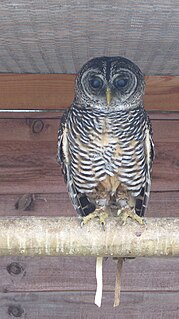
The rufous-legged owl is a medium-sized owl with no ear tufts. Its upper parts are rufous brown barred with white with more white on the head and nape. It has a rufous facial disk and dark eyes, and its legs and feet are orange-brown to cinnamon. It reaches sizes of about 33–38 cm long and weighs about 300-400 grams. Its range stretches from central Chile and west Argentina to Tierra del Fuego and is occasionally spotted on the Falkland Islands. It lives in dense, moist montane forest and semi-open lowland forest where it can catch small mammals, birds, and insects. It breeds in October and lays 2-3 eggs in a tree hollow. Its call is a rapid grunting followed by high pitched nasal noises. Though it is not threatened it does suffer habitat loss because of logging in a large part of its range.
Leptomantis rufipes is a species of frog in the family Rhacophoridae. It is endemic to Borneo and known from isolated locations in south-central Sarawak and eastern Sabah and central Kalimantan (Indonesia). Common names Malaysian flying frog and red-legged frog have been coined for this species. The specific name rufipes refers to the red webbing of this frog.

The red side-necked turtle, red turtle, red-footed sideneck turtle, William's toadhead turtle, or red-footed Amazon side-necked turtle is a monotypic species of turtle in the family Chelidae. It is found in Colombia and possibly Peru and Brazil. This species is dimorphic in size meaning the sexes show different characteristics. One study found that the largest female out of a group of 24 was 256 mm in carapace length. Out of that same group, the largest male was only 199 mm in carapace length.
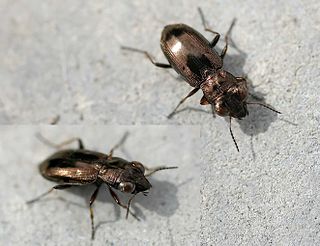
Notiophilus rufipes is a genus of ground beetle native to the Palearctic and the Near East. In Europe, it is found in Albania, Austria, Belgium, Bosnia and Herzegovina, Great Britain including the Isle of Man, Bulgaria, Corsica, Croatia, the Czech Republic, mainland Denmark, Estonia, mainland France, Germany, mainland Greece, Hungary, mainland Italy, Kaliningrad, Liechtenstein, Luxembourg, Moldova, North Macedonia, mainland Norway, Poland, mainland Portugal, central, northern and southern Russia, Sardinia, Sicily, Slovakia, Slovenia, mainland Spain, Sweden, Switzerland, the Netherlands and Ukraine.

Zygoballus rufipes, commonly called the hammerjawed jumper, is a species of jumping spider which occurs in the United States, Canada, and Central America. Adult females are 4.3 to 6 mm in body length, while males are 3 to 4 mm.

Necrobia rufipes, the red-legged ham beetle, is a species of predatory beetle, in the family Cleridae, with a cosmopolitan distribution, first described by Charles De Geer in 1775.
Chalcorana rufipes is a species of "true frog" in the family Ranidae. It is endemic to Sumatra, Indonesia. It was split off from Chalcorana chalconota by Robert Inger and colleagues in 2009, along with a number of other species. The specific name rufipes is derived from Latin rufus meaning reddish and pes meaning foot, in reference to the reddish tinge on the underside of the pedal webbing in life.

Nesticodes is a monotypic genus of comb-footed spiders containing only the red house spider [Nesticodes rufipes ]. It was first described by Allan Frost Archer in 1950, and has a pantropical distribution due to ship and air travel.
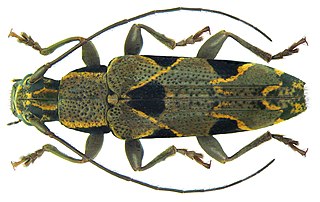
Tmesisternini is a tribe of beetles in the subfamily Lamiinae containing the following genera:
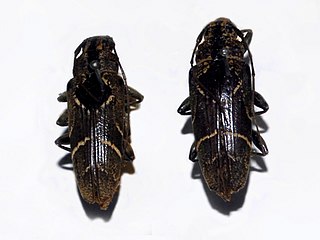
Tmesisternus is a genus of longhorn beetles belonging to the family Cerambycidae, subfamily Lamiinae.
Phytoecia rufipes is a species of beetle in the family Cerambycidae. It was described by Olivier in 1795. It has a wide distribution in Europe and the Middle East. It feeds on Foeniculum vulgare.
Tmesisternus dubius is a species of beetle in the family Cerambycidae. It was described by Xavier Montrouzier in 1855.
Tmesisternus jaspideus is a species of beetle in the family Cerambycidae. It was described by Jean Baptiste Boisduval in 1835.
Tmesisternus schaumii is a species of beetle in the family Cerambycidae. It was described by Francis Polkinghorne Pascoe in 1867. It is known from Moluccas, Australia, and the Solomon Islands.
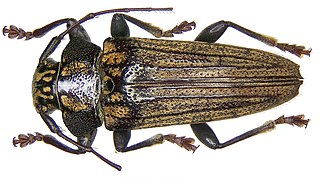
Tmesisternus venatus is a species of beetle in the family Cerambycidae. It was described by James Thomson in 1864.

Pimpla rufipes, the black slip wasp, is a species of wasp belonging to the family Ichneumonidae.

Promachus rufipes, known generally as the red-footed cannibalfly or bee panther, is a species of robber flies.














